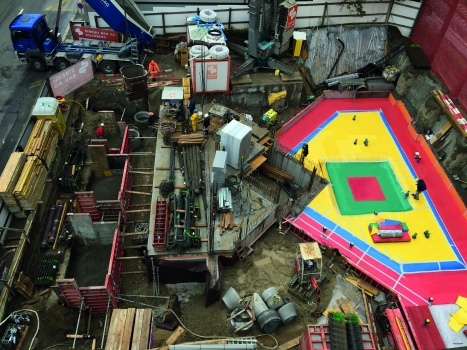VIBRAX®PUR – Vibration Isolation Mats
The VIBRAX®PUR product range is used as an elastic bearing element in various fields of application. Main applications as full-surface mount, strip or discrete bearing include the machinery and construction industries as well as the railway sector. VIBRAX®PUR is an economic solution in the area of structure-borne sound decoupling and vibration isolation thanks to its long-term stability and simple installation.
Principle
Vibration isolation is becoming increasingly important in the construction industry and in mechanical engineering. The noise and the vibrations caused have a negative impact on the environment and may lead to structural damage and health concerns. Vibration bearings made of VIBRAX®PUR form the link between a dynamically inducing system and the system to be protected. As a bearing element, VIBRAX®PUR highly efficiently reduces noise and vibrations.
Properties
- VIBRAX®PUR is a mixed cellular elastomer and is made of a special polyurethane.
- In contrast to non-cellular materials, VIBRAX®PUR exhibits gas volumes embedded in the structure. As a result, the material is volume compressible under static and dynamic load. This means that the spring stiffness does not exclusively depend on shore hardness and shape. The load deflection curve is almost linear up to the maximum static constant load. With higher loads on the bearings, a degressive behaviour follows, which allows the bearing to react to additional dynamic forces particularly softly, enabling optimal vibration isolation.
- Due to the special polymer structure VIBRAX®PUR is not affected by brief peak loads. The material almost completely returns to its starting position after temporary overloads.
- VIBRAX®PUR exhibits a very low dynamic stiffening factor and enables high isolation efficiency even with low bearing thicknesses.
- Special types with adapted strengths can also be manufactured.
Aspects of vibration isolation
With vibration isolation, mass is decoupled from the foundation by the means of a damping spring. Two forms of vibration are to be distinguished:
- active vibration isolation that minimises vibrations in the direct surroundings of the exciter
- passive vibration isolation that shields the object to be protected from external impacts
The effectiveness of vibration isolation depends on the coupled masses and the flexibility of the spring used. The following basically applies: The softer the spring the better the vibration isolation at frequencies above the (√2-fold) resonance frequency. A low-tuned bearing with "soft" springs causes sinking under static load to a great extent.
Even small variations in load may cause large relative movements between the foundation and the object to be supported. As the requirement of maximum vibration isolation with a "soft" spring is confronted with stability, the implementation of vibration isolation usually consists of a compromise.
In first-order approximation, an elastically supported system may be considered as a damped single-mass oscillator (figure 3). This model theoretically assumes dynamic infinitely stiff masses and a rigid foundation. This generally applies to exciter masses which are very small compared to the foundation. In remark, considerations have to be amended if discontinuous impact forces are impinging on the system instead of continuous exciter forces.
Aspects of implementation
In the simplest case (one-dimensional mass-spring-system) of vibration isolation with an elastomer, the calculated natural frequencies can be found in the product data sheets using the static pressure. Depending on the implementation, the required frequency ratio f/f0 – according to which the necessary thickness of VIBRAX®PUR and the pressure can be calculated – can be determined using a required isolation efficiency or isolation value.
Delivery form
- Material: mixed cellular polyether-urethane
- Thickness: 12.5 mm and 25 mm
- Mats: 2.0 m long, 0.5 m wide
- Other dimensions available on request (incl. stamped and molded components)
Application
The VIBRAX®PUR product range is used as an elastic bearing element in various fields of application. Main applications as fullsurface mount, strip or discrete bearing include the machinery and construction industries as well as the railway sector. VIBRAX®PUR is an economic solution in the area of structure-borne sound decoupling and vibration isolation thanks to its long-term stability and simple installation.
Application Areas
Industry
VIBRAX®PUR is used for elastic bearings of machines and systems as well as floor constructions. According to the structure and individual needs full-surface, strip or point bearings can be realised.
Construction
As part of vibration protection measures, e.g. for construction projects in close proximity to railway lines, VIBRAX®PUR is used for the decoupling of entire buildings. The type of bearings depends on the required tuning frequency and the constructive marginal conditions. Due to careful planning and realisation, the air-borne sound level in the building is reduced audibly.
Railway
VIBRAX®PUR is used in overground and underground railway transport in order to minimise vibrations transmitted into the ground. By means of the PUR mats the track system is completely separated from its environment.
References
Relevant Websites
- About this
data sheet - Product-ID
7458 - Published on:
17/01/2017 - Last updated on:
17/11/2021




 mageba group
mageba group




